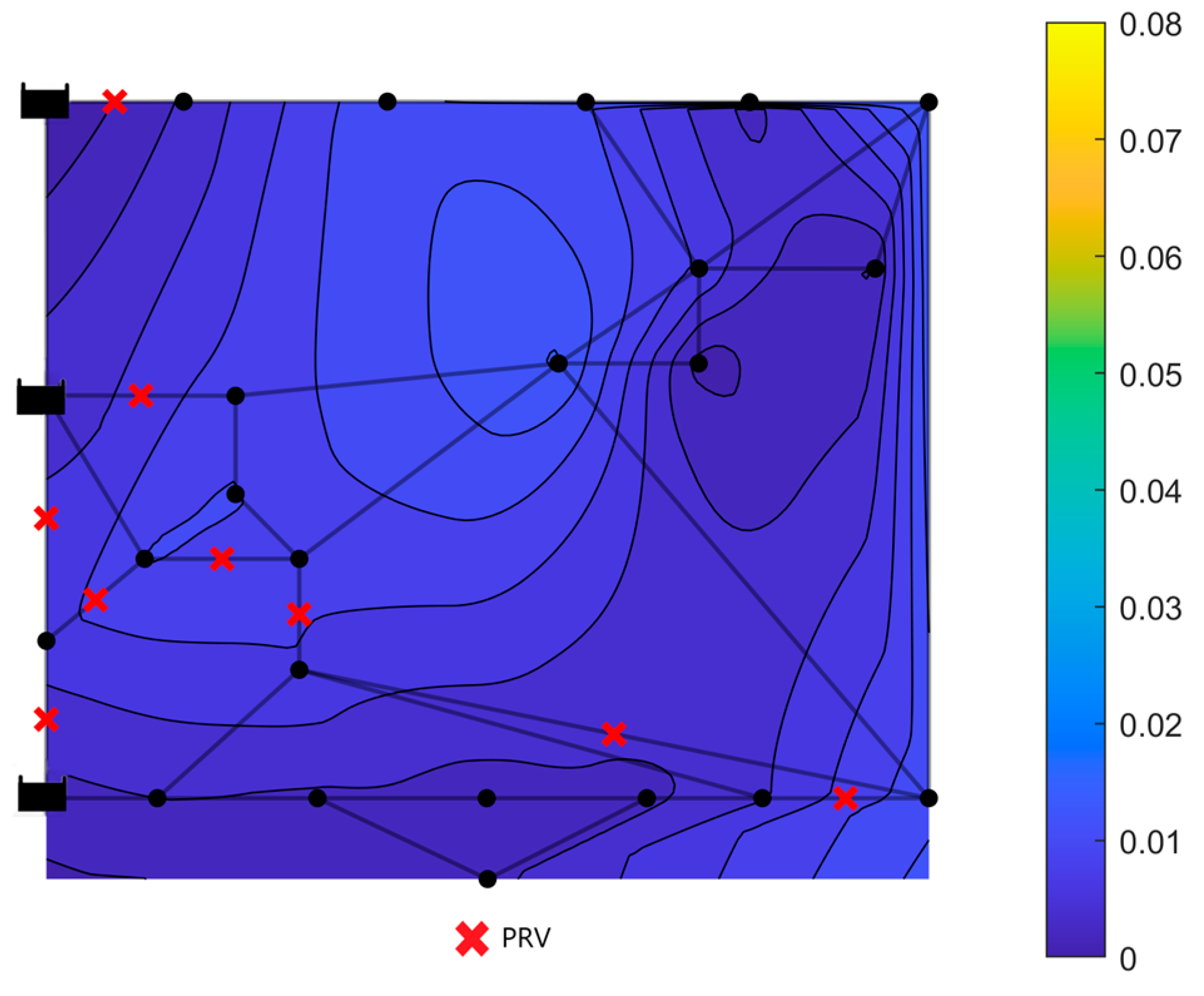Energy Assessment of Water Networks Based on New Performance Indicators †
Abstract
1. Introduction
2. Materials and Methods
2.1. The Performance Indices
2.2. The Case Study
3. Results and Discussion
4. Conclusions
Author Contributions
Funding
Institutional Review Board Statement
Informed Consent Statement
Data Availability Statement
Conflicts of Interest
References
- Morani, M.C.; Carravetta, A.; D’Ambrosio, C.; Fecarotta, O. A new mixed integer non-linear programming model for optimal PAT and PRV location in water distribution networks. Urban Water J. 2021, 18, 394–409. [Google Scholar] [CrossRef]
- Zhang, L.; Wang, X.; Wu, P.; Huang, B.; Wu, D. Optimization of a centrifugal pump to improve hydraulic efficiency and reduce hydro-induced vibration. Energy 2023, 268, 126677. [Google Scholar] [CrossRef]
- Cabrera, E.; Pardo, M.A.; Cobacho, R.; Cabrera, E.J. Energy Audit of Water Networks. J. Water Resour. Plan. Manag. 2010, 136, 669–677. [Google Scholar] [CrossRef]
- Morani, M.C.; Carravetta, A.; Fecarotta, O.; Montillo, R. Detailed Audit of the Energy Efficiency in Water Systems: New Performance Indices. Water Resour. Manag. 2024, 38, 1241–1260. [Google Scholar] [CrossRef]


| Scenario 0 | 0.117 | 0.356 | 0.040 | 0.104 | - | 0.617 |
| Scenario I | 0.117 | 0.044 | 0.005 | 0.009 | 0.264 | 0.175 |
Disclaimer/Publisher’s Note: The statements, opinions and data contained in all publications are solely those of the individual author(s) and contributor(s) and not of MDPI and/or the editor(s). MDPI and/or the editor(s) disclaim responsibility for any injury to people or property resulting from any ideas, methods, instructions or products referred to in the content. |
© 2024 by the authors. Licensee MDPI, Basel, Switzerland. This article is an open access article distributed under the terms and conditions of the Creative Commons Attribution (CC BY) license (https://creativecommons.org/licenses/by/4.0/).
Share and Cite
Morani, M.C.; Carravetta, A.; Fecarotta, O.; Montillo, R. Energy Assessment of Water Networks Based on New Performance Indicators. Eng. Proc. 2024, 69, 128. https://doi.org/10.3390/engproc2024069128
Morani MC, Carravetta A, Fecarotta O, Montillo R. Energy Assessment of Water Networks Based on New Performance Indicators. Engineering Proceedings. 2024; 69(1):128. https://doi.org/10.3390/engproc2024069128
Chicago/Turabian StyleMorani, Maria Cristina, Armando Carravetta, Oreste Fecarotta, and Renato Montillo. 2024. "Energy Assessment of Water Networks Based on New Performance Indicators" Engineering Proceedings 69, no. 1: 128. https://doi.org/10.3390/engproc2024069128
APA StyleMorani, M. C., Carravetta, A., Fecarotta, O., & Montillo, R. (2024). Energy Assessment of Water Networks Based on New Performance Indicators. Engineering Proceedings, 69(1), 128. https://doi.org/10.3390/engproc2024069128









